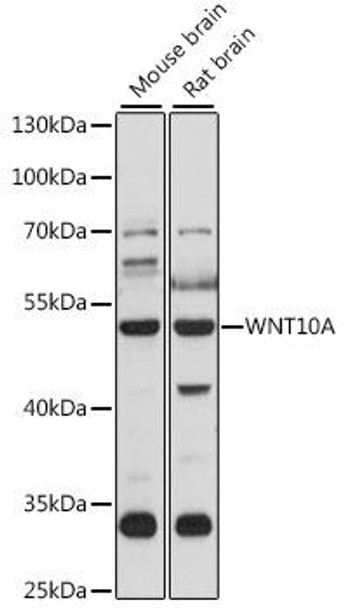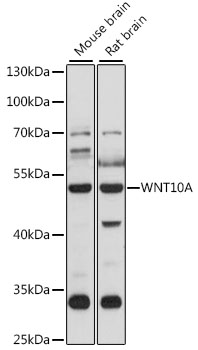Anti-WNT10A Antibody (CAB15602)
- SKU:
- CAB15602
- Product type:
- Antibody
- Reactivity:
- Human
- Mouse
- Rat
- Host Species:
- Rabbit
- Isotype:
- IgG
- Antibody Type:
- Polyclonal Antibody
- Research Area:
- Metabolism
Frequently bought together:
Description
| Antibody Name: | Anti-WNT10A Antibody |
| Antibody SKU: | CAB15602 |
| Antibody Size: | 20uL, 50uL, 100uL |
| Application: | WB |
| Reactivity: | Human, Mouse, Rat |
| Host Species: | Rabbit |
| Immunogen: | Recombinant fusion protein containing a sequence corresponding to amino acids 158-417 of human WNT10A (NP_079492.2). |
| Application: | WB |
| Recommended Dilution: | WB 1:500 - 1:2000 |
| Reactivity: | Human, Mouse, Rat |
| Positive Samples: | Mouse brain, Rat brain |
| Immunogen: | Recombinant fusion protein containing a sequence corresponding to amino acids 158-417 of human WNT10A (NP_079492.2). |
| Purification Method: | Affinity purification |
| Storage Buffer: | Store at -20°C. Avoid freeze / thaw cycles. Buffer: PBS with 0.02% sodium azide, 50% glycerol, pH7.3. |
| Isotype: | IgG |
| Sequence: | GCDA SRRG DEEA FRRK LHRL QLDA LQRG KGLS HGVP EHPA LPTA SPGL QDSW EWGG CSPD MGFG ERFS KDFL DSRE PHRD IHAR MRLH NNRV GRQA VMEN MRRK CKCH GTSG SCQL KTCW QVTP EFRT VGAL LRSR FHRA TLIR PHNR NGGQ LEPG PAGA PSPA PGAP GPRR RASP ADLV YFEK SPDF CERE PRLD SAGT VGRL CNKS SAGS DGCG SMCC GRGH NILR QTRS ERCH CRFH WCCF VVCE ECRI TEWV SVCK |
| Gene ID: | 80326 |
| Uniprot: | Q9GZT5 |
| Cellular Location: | Secreted, extracellular matrix, extracellular space |
| Calculated MW: | 46kDa |
| Observed MW: | 46kDa |
| Synonyms: | WNT10A, OODD, SSPS, STHAG4 |
| Background: | The WNT gene family consists of structurally related genes which encode secreted signaling proteins. These proteins have been implicated in oncogenesis and in several developmental processes, including regulation of cell fate and patterning during embryogenesis. This gene is a member of the WNT gene family. It is strongly expressed in the cell lines of promyelocytic leukemia and Burkitt's lymphoma. In addition, it and another family member, the WNT6 gene, are strongly coexpressed in colorectal cancer cell lines. The gene overexpression may play key roles in carcinogenesis through activation of the WNT-beta-catenin-TCF signaling pathway. This gene and the WNT6 gene are clustered in the chromosome 2q35 region. |
| UniProt Protein Function: | WNT10A: Ligand for members of the frizzled family of seven transmembrane receptors. Probable developmental protein. May be a signaling molecule important in CNS development. Is likely to signal over only few cell diameters. Defects in WNT10A are a cause of ectodermal dysplasia anhidrotic (EDA); also known ectodermal dysplasia hypohidrotic autosomal recessive (HED). Ectodermal dysplasia defines a heterogeneous group of disorders due to abnormal development of two or more ectodermal structures. EDA is characterized by sparse hair (atrichosis or hypotrichosis), abnormal or missing teeth and the inability to sweat due to the absence of sweat glands. Most patients carrying WNT10A mutations present with sweating anomalies. However, comparison with EDA cases harboring mutations in the ectodysplasin pathway identifies some phenotypic differences. Dermatological features (anomalies of hair and sweat glands) are less severe in patients carrying WNT10A mutations and facial dysmorphism can be absent. The dental phenotype consists in microdontia, whereas teeth agenesis is more frequent in patients carrying mutations in the ectodysplasin pathway. Defects in WNT10A are a cause of odonto-onycho-dermal dysplasia (OODD). OODD is a rare autosomal recessive ectodermal dysplasia in which the presenting phenotype is dry hair, severe hypodontia, smooth tongue with marked reduction of fungiform and filiform papillae, onychodysplasia, keratoderma and hyperhidrosis of palms and soles, and hyperkeratosis of the skin. Defects in WNT10A are a cause of Schopf-Schulz-Passarge syndrome (SSPS). SSPS is rare ectodermal dysplasia, characterized chiefly by cysts of the eyelid margins, palmoplantar keratoderma, hypodontia, hypotrichosis and nail dystrophy. Multiple eyelid apocrine hidrocystomas are the hallmark of this condition, although they usually appear in adulthood. The concomitant presence of eccrine syringofibroadenoma in most patients and of other adnexal skin tumors in some affected subjects indicates that Schopf-Schulz-Passarge syndrome is a genodermatosis with skin appendage neoplasms. Belongs to the Wnt family. |
| UniProt Protein Details: | Protein type:Secreted, signal peptide; Secreted Chromosomal Location of Human Ortholog: 2q35 Cellular Component: extracellular space; proteinaceous extracellular matrix; extracellular region Molecular Function:frizzled binding Biological Process: skin development; neuron differentiation; odontogenesis; tongue development; hair follicle morphogenesis; Wnt receptor signaling pathway; cell fate commitment; hair follicle development; epidermis morphogenesis; sebaceous gland development; neural crest cell differentiation; regulation of odontogenesis of dentine-containing teeth Disease: Schopf-schulz-passarge Syndrome; Tooth Agenesis, Selective, 4; Odontoonychodermal Dysplasia |
| NCBI Summary: | The WNT gene family consists of structurally related genes which encode secreted signaling proteins. These proteins have been implicated in oncogenesis and in several developmental processes, including regulation of cell fate and patterning during embryogenesis. This gene is a member of the WNT gene family. It is strongly expressed in the cell lines of promyelocytic leukemia and Burkitt's lymphoma. In addition, it and another family member, the WNT6 gene, are strongly coexpressed in colorectal cancer cell lines. The gene overexpression may play key roles in carcinogenesis through activation of the WNT-beta-catenin-TCF signaling pathway. This gene and the WNT6 gene are clustered in the chromosome 2q35 region. [provided by RefSeq, Jul 2008] |
| UniProt Code: | Q9GZT5 |
| NCBI GenInfo Identifier: | 14424011 |
| NCBI Gene ID: | 80326 |
| NCBI Accession: | Q9GZT5.1 |
| UniProt Secondary Accession: | Q9GZT5,Q53S44, Q96TA7, Q9H7S8, |
| UniProt Related Accession: | Q9GZT5 |
| Molecular Weight: | 46,444 Da |
| NCBI Full Name: | Protein Wnt-10a |
| NCBI Synonym Full Names: | wingless-type MMTV integration site family, member 10A |
| NCBI Official Symbol: | WNT10A |
| NCBI Official Synonym Symbols: | OODD; SSPS; STHAG4 |
| NCBI Protein Information: | protein Wnt-10a |
| UniProt Protein Name: | Protein Wnt-10a |
| UniProt Gene Name: | WNT10A |
| UniProt Entry Name: | WN10A_HUMAN |








